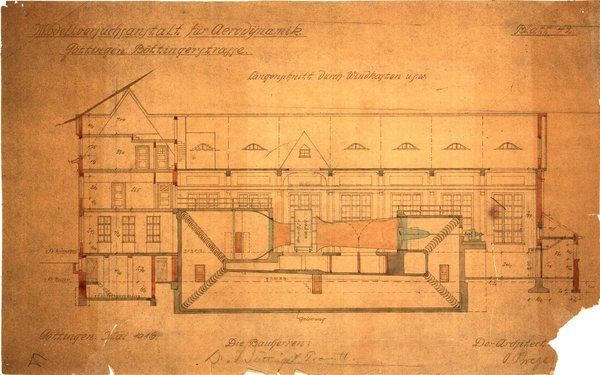
History of the institute
The early history of the Max Planck Institute for Dynamics and Self-Organization is closely linked to the work of the famous physicist Ludwig Prandtl. Prandtl is regarded as the founder of fluid dynamics and especially made a name for himself with his boundary layer theory. In Göttingen Prandtl opened two research facilities that both exist until today: in 1915 the Aerodynamical Experimental Station (German abbreviation AVA), which concentrated on application-oriented topics in fluid dynamics and evolved into the Göttinger branch of the German Space Agency DLR, and in 1924 the Kaiser Wilhelm Institute for Fluid Dynamics. The latter mainly dealt with fundamental research in the field of fluid dynamics. After the Max Planck Society was founded the institute was renamed Max Planck Institute for Fluid Dynamics. In 2004 the institute again received a new name and is now called Max Planck Institute for Dynamics and Self-Organization.
In 1904 Ludwig Prandtl accepted a position as professor for Technical Physics at the University of Göttingen. Here he continued his research in fluid dynamics that he had started as professor in Hannover. One of his experimental setups was a water channel, into which different obstacles could be inserted. Soon however, Prandtl wished to conduct more application-oriented research in larger test facilities. This became possible in 1907 with the foundation of an experimental facility in the Hildebrandt Street. Here Prandtl built the first German wind tunnel and thereby established the so-called "Göttinger type" of wind tunnels. Unlike those created by Gustav Eiffel in France wind tunnels of the Göttinger type feature a closed cycle for the liquids or gases to flow in (see sketch above). The founding of this experimental facility is the starting point of the later Aerodynamical Experimental Station.
When on January 11th, 1911 the Kaiser Wilhelm Society, the preceding organisation of the Max Planck Society, was founded in Berlin, Prandtl acted again. Only one month later he appealed to the Kaiser Wilhelm Society in a memorandum. In it he asked for an institute for fundamental research in fluid dynamics to be built in Göttingen. As reasons for his choice of location he listed his own previous research and the high esteem of mathematics at the University of Göttingen.
The following negotiations lasted for over a decade and were interrupted by World War I. The Kaiser Wilhelm Institute for Fluid Dynamics was not opened until 1924. It was located on the premises between Böttinger and Bunsen Street, where it is still found today. Ludwig Prandtl was appointed head of the institute. Before, in 1915 the application-oriented Aerodynamical Experimental Station had been founded at the same location. The wind tunnel that Prandtl had built in the Hildebrandt Street was moved to the Bunsen Street in 1918. With the foundation of the Kaiser Wilhelm Institute both the new institute and the Aerodynamical Experimental Station were united under the name "Kaiser Wilhelm Institute for Fluid Dynamics together with the Aerodynamical Experimental Station". During the National Socialist era, the AVA was separated from the Kaiser Wilhelm Institute. A critical analysis of this time period can be found in the article by Eberhard Bodenschatz and Michael Eckert and in the Prandtl biography by M. Eckert.
On April 11th, 1945 the British military government temporarily closed the Kaiser-Wilhelm-Institute and the Aerodynamical Experimental Station and installed a committee to decide about the future of both research facilities. In June a decision was made: The Aerodynamical Experimental Station was permanently closed and its experiments were dissembled. Having been built for the purpose of fundamental research only, the Kaiser Wilhelm Institute was permitted to carry on its work and was reopened on August 1st, 1946. In the same year Ludwig Prandtl resigned as head of the institute. His successor was Albert Betz, who had led the Aerodynamical Experimental Station for years. Walter Tollmien became a scientific member of the institute in the same year. The foundation of the Max Planck Society as successor organization of the Kaiser Wilhelm Society on February 26, 1948 in Göttingen also had an impact on the Institute of Fluid Dynamics Research. From then on, it was called the "Max Planck Institute for Fluid Dynamics Research". After the retirement of A. Betz, W. Tollmien took over as director in 1957 until 1968.
Also in 1969 the Max Planck Institute began to focus on new fields of research and received three departments for molecular physics: Atomic and Molecular Physics, Molecular Interactions and Reaction Kinetics. In the following years this field of research became more and more important until in 1993 the institute discontinued all research in fluid dynamics.
In 1996 the institute again chose a new research focus and appointed Prof. Dr. Theo Geisel, who opened the Department of Nonlinear Dynamics. By 2001 all departments dealing with molecular physics had been closed. With the appointment of Prof. Dr. Stephan Herminghaus and Prof. Dr. Eberhard Bodenschatz in 2003 and the founding of the Department of Dynamics of Complex Fluids and the Department of Hydrodynamics, Pattern Formation and Nanobiocomplexity, fluid dynamics returned to the institute. However, now this field of research was put into the larger context of self-organized and nonlinear phenomena. This development led to the renaming of the institute on November 19th 2004. Since then the institute is called Max Planck Institute for Dynamics and Self-Organization.
In September 2016 Prof. Dr. Geisel became Emeritus and is operating his department Nonlinear Dynamics as an Emeritus group. In March 2018 Prof. Dr. Ramin Golestanian was appointed as Director at the institute and founded the department Living Matter Physics.
End of June 2023, Prof. Dr. Stephan Herminghaus became Emeritus. After heading the department Dynamics of Complex Fluids for 20 years he is now leader of the Emeritus group Dynamics of Social Systems.